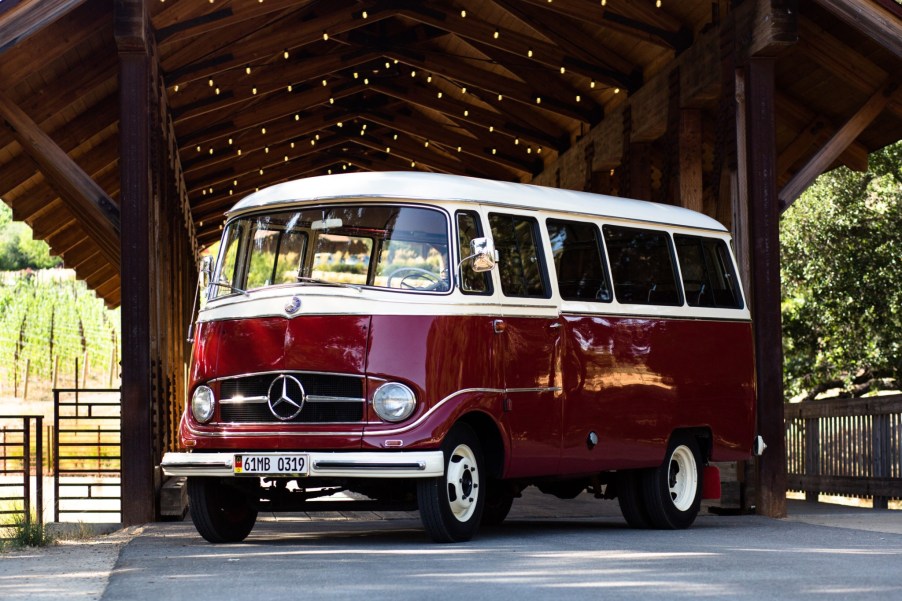
Want a German Chevy Van? Try a Mercedes Omnibus
In the US, Mercedes is mostly thought of as a luxury brand. Even the brand’s wackier products, like the 6-wheeled G-Wagon pickup and 500-hp R-Class minivan, offer high-end features. But the truth is Mercedes also makes more utilitarian vehicles, like the Unimog, Metris camper, and Sprinter cargo van. Though that perhaps shouldn’t be too surprising, considering the G-Wagon’s military ties. Unfortunately, the US-market Metris can’t quite match that other iconic people-hauler, the Chevy van, for seating capacity. There’s another Mercedes, though, that can: the Mercedes Omnibus.
What is the Mercedes Omnibus?

The Mercedes Omnibus name actually dates back almost to the beginning of the company’s history. In fact, Mercedes offered an 8-passenger vehicle called the Omnibus in 1895, only 10 years after the original Benz-Patent Motorwagen was built. ‘Omnibus’ was the term given to a multi-passenger vehicle, though it dropped out of use.
Mercedes, though, brought it back in 1955, when it debuted the O319, Bring a Trailer reports. This was based on the company’s L319 line of light-duty trucks and vans, and it was Mercedes’ first light transport sector.

Technically, the Mercedes Omnibus is a minibus, Hemmings reports, rather than a van like the Chevy van. However, considering you could order it with seats for 10-18 passengers, the two vehicles share a common end-goal. Namely, moving large groups of people from point A to point B. Also, the Mercedes came out almost a decade before the Chevy Express van’s predecessors.

Also, if the Fiat 600 Multipla is considered a minivan, and the Corvair Greenbrier considered a van like the VW Bus, it’s fair to compare the Omnibus to a van.
Can you still get a civilian Mercedes Omnibus?
Technically, like the Unimog line, Mercedes didn’t officially sell the Omnibus in the US. However, BaT reports a handful of models did end up in the US during the 60s. These were often used as ski-resort transport, or by collegiate sports teams, Classic Driver reports. And, while there isn’t a Mercedes vehicle called ‘Omnibus’ anymore, the company still makes commercial buses and vans. So, in a way, the modern Sprinter is a descendant of the Omnibus.
However, Mercedes’ buses have been rather forward-thinking. Not only is Mercedes working on an electric minivan, in 1971, the automaker created the first natural-gas-powered bus. In fact, there was an all-electric Omnibus running around as early as 1975.

Also, Motor1 reports Mercedes’ owner Daimler is working with Volvo to develop hydrogen-powered buses. But Mercedes already has some history in this segment. An Omnibus ran on an experimental hydrogen fuel-cell way back in 1975.
Turns out, that electric Morris JE isn’t as forward-thinking as one would think.
Pricing and availability

A Mercedes Omnibus rarely shows up for sale in the US. Hemmings reports the O319 models have something of a European cult following, and they command VW Bus-level prices at times. For example, as of this writing, Classic Driver lists a restored 1960 model that’s listed for the equivalent of $163,000.

But, if you look hard enough, you can find one. As of this writing, BaT lists a 17-passenger 1961 model with a bid of $20,500. It, too, has been restored, with the stock 1.8-liter diesel and 4-speed manual replaced with a 2.2-liter Toyota four-cylinder and 5-speed manual.
Plus, pulling up in a plain white Chevy van just wouldn’t be as stylish.
Follow more updates from MotorBiscuit on our Facebook page.


